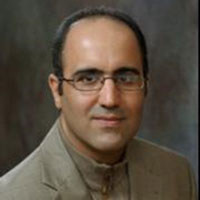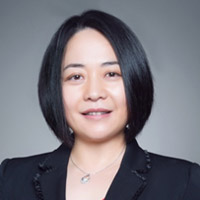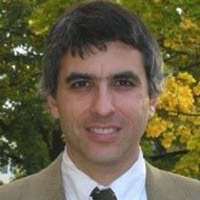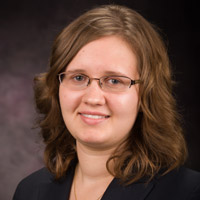Monday, June 24

Plenary Speaker – 7:45 AM – 8:35 AM
Dirk Janasek, Leibniz Institute of Analytical Sciences
“Microfluidics for Life Science Applications and Analytics “
Abstract: Microfluidic systems have gained considerable attention over the last three decades because of their advantages according to scaling laws. While there are many approaches and attempts in (basic) research, only few made it to mass production and routine applications. Such difficulties in the translation from research to application often originate from the rapid prototyping processes used in the research environment, the sometimes poor reproducibility and an often not very simple applicability for non-experts. Thus, overcoming these restrictions is a major task to promote the acceptance and usage of microfluidic devices.
One focus in our group is the establishment and optimization of free-flow electrophoresis (FFE) in a miniaturized format. FFE can be applied to upstream sample preparation and downstream product purification due to the continuous electrophoretic separation in a two-dimensional fashion. The miniaturization of this technique allows the handling of minute amounts of sample and reagents, and even enables the implementation of special separation modes. A big challenge is the design of electrodes structures for voltage coupling preventing electrolysis-generated gas bubbles entering the separation compartment since they can cause disturbances of the separation process.
Another focus is the coupling of miniaturized FFE (µFFE) to new detection methods. The widespread fluorescence detection requires intrinsic fluorescence or the employment of fluorescent dyes which e.g. conflicts with the product purification part. Thus, non-destructive detection like molecular spectroscopy would be favorable. However, due to its great importance in the biochemical field and for quality control also interfacing to mass-spectrometry becomes a big issue.
Bio: Dirk Janasek studied Biochemistry at the Martin-Luther-University Halle–Wittenberg (Germany) and received his PhD degree in the field of chemiluminometric biosensors. After a postdoc working on amperometric biosensors, he joined the Manz group at Imperial College London in 2002 as a Leopoldina scholarship holder where he became acquainted with the lab-on-a-chip field. Since 2003 he is employed at ISAS and responsible for microfluidics and miniaturized separation systems to be applied to the preparation, manipulation and analytics of minute sample amounts of bio-/chemical/technological and clinical origin.

Keynote Speaker – 8:35 AM – 9:00 AM
Barbaros Cetin, Bilkent University
“Modeling of Bio-particle Motion in Microchannels”
Abstract: Manipulation of the biological particles is the main ingredient for many microfluidic applications. Modeling of the motion of particles with different geometry and size in microchannels is crucial for the design of microfluidic platforms. For the manipulation of particles, there are passive hydrodynamic techniques which utilizes the channel geometry and flow field as well as active techniques which employs external forces such as electric, acoustic, magnetic and/or optic. For microfluidic applications, there are commonly two approaches to simulate the particle trajectories: (i) Lagrange tracking method, (ii) stress tensor method. In Lagrange tracking method, flow, electric and/or acoustic fields are obtained by neglecting the presence of particles (i.e. assuming particles as point particles). This approach is acceptable when the size of the particles is small relative to the microchannel, and for the dilute solution in which the particle-particle interactions can be neglected. In stress tensor method, the field variables are determined with presence of the finite particle size. In this approach, resulting forces and torques acting on the particles are obtained by integrating the corresponding tensors. Therefore, particle-particle and/or particle-wall interactions can be captured. Volume based numerical models are faced with algorithmic and computational challenges in resolving complex particle shapes and in efficient implementation of particle motion. In addition, resolution of interactions between close particles and surfaces often require unusually high mesh density. These challenges are eliminated by using the Boundary Element Method (BEM) that requires discretization of the particle and channel surfaces, which effectively reduces 3D problems to 2D, and 2D problems to 1D. In addition, the derivative of the field variables which are essential for calculation of the forces acting on the particles comes as a part of the solution without requiring any numerical approximation. In this talk, different modelling strategies will be discussed and modeling of different cases for hydrodynamic, electrokinetic and acoustophoretic bioparticle manipulation will be presented.
Bio: Dr. Barbaros Çetin received his B.S. (2002) and M.S. (2005) in Mechanical Engineering at Middle East Technical University, Ankara, Turkey. He received his PhD (2009) in the Department of Mechanical Engineering at Vanderbilt University where he focused on electrokinetic transport and particle manipulation in lab-on-a-chip devices for biomedical applications. Following his PhD, he became a faculty member in Middle East Technical University-Northern Cyprus Campus Mechanical Engineering Program. In 2011, he became a faculty member in the Mechanical Engineering Department at I.D. Bilkent University, Ankara, Turkey. His current research interests include particle manipulation for microfluidic applications, modeling of particle motion using boundary element method, and modeling, fabrication and experimentation of flat-grooved heat pipes. Dr. Çetin is the recipient of the 2015 Bilkent University Distinguished Teacher Award, 2017 Outstanding Young Scientist Award of the Turkish Academy of Sciences (TÜBA-GEBİP), 2017 METU Prof. Dr. Mustafa N. Parlar Research Incentive Award and 2018 Science Academy Association Distinguished Young Scientist Award (BAGEP).

Plenary Speaker – 9:15 AM – 10:05 AM
MinJun Kim, Southern Methodist University
“Transport in Nanopores for Single Molecule and Single Cell Analysis”
Abstract: Solid state nanopores were developed almost a decade ago as an alternative to protein nanopores for next-generation sequencing of DNA molecules. In recent years, however, they have drawn significant attention as an analytical tool to study other nanoscale analytes. Compared to biological nanopores, solid-state nanopores are more robust and can be tuned in size and geometry to meet various requirements for a wide range of applications. A size scale that spans from single macro-molecules (<10 nm) to single-particle viruses (50-200 nm) and even single-cell microorganisms such as bacteria (1 - 2 µm) makes solid-state nanopores a powerful analytical tool for single-particle, single-molecule or single-cell research. In fact, nanopore can provide a unique opportunity to bridge the gap between single-molecule and single-cell research. In this presentation, we first review micro/nano-fabrication techniques to achieve a wide range of pore size and geometry and then discuss applications in sensing and biophysical analysis of single-molecules and single cells. Particularly, we will review our recent works on single-protein research including protein binding and protein-protein interactions as well as single-virus research for sensing human immunodeficiency virus (HIV) and study biophysical deformation of single viruses as they translocate through the pore.
Bio: Dr. MinJun Kim is presently the Robert C. Womack Endowed Chair Professor of Engineering at the Department of Mechanical Engineering, Southern Methodist University. He received his B.S. and M.S. degrees in Mechanical Engineering from Yonsei University in Korea and Texas A&M University, respectively. Dr. Kim completed his Ph.D. degree in Engineering at Brown University, where he held the prestigious Simon Ostrach Fellowship. Following his graduate studies, Dr. Kim was a postdoctoral research fellow at the Rowland Institute in Harvard University. He joined Drexel University in 2006 as Assistant Professor and was later promoted to Professor of Mechanical Engineering and Mechanics. Dr. Kim has been exploring biological transport phenomena including cellular/molecular mechanics and engineering in novel nano/microscale architectures to produce new types of nanobiotechology, such as nanopore technology and nano/micro robotics. His notable awards include the National Science Foundation CAREER Award (2008), Drexel Career Development Award (2008), Human Frontier Science Program Young Investigator Award (2009), Army Research Office Young Investigator Award (2010), Alexander von Humboldt Fellowship (2011), KOFST Brain Pool Fellowship (2013 & 2015), Bionic Engineering Outstanding Contribution Award (2013), Louis & Bessie Stein Fellowship (2008 & 2014), ISBE Fellow (2014), ASME Fellow (2014), Top10 Netexplo Award (2016), KSEA & KOFST Engineer of the Year Award (2016), IEEE Senior Member (2017), and Gerald J. Ford Research Fellowship (2018).

Keynote Speaker – 10:05 AM – 10:30 AM
Ashlee Ford Versypt, Oklahoma State University
“Mathematical modeling of macromolecule transport in dynamic, heterogeneous micropores within biomaterials”
Abstract: Chemical reactions that remodel or degrade porous biomaterials such as polymeric drug delivery devices for extended release pharmaceuticals or extracellular fibrous matrices in various tissues are ubiquitous. Often these porous materials are considered as static environments through with molecular transport occurs or over which cell migration occurs. However, the pore structure and the stiffness of these biomaterials can evolve heterogeneously over time resulting in a dynamic domain for biotransport. We have developed mathematical models to account for a variety of transport modes in biomaterials undergoing remodeling reactions. Case studies of macromolecular protein drug release from porous bulk-eroding polymer microspheres, migration of cancer cells over a remodeling extracellular matrix in a tumor microenvironment, escape of bacteria through degraded tuberculosis granulomas, and transport of proteins through filtration tissues in the kidney subject to diabetic glucose-induced tissue damage will be discussed.
Bio: Dr. Ashlee N. Ford Versypt holds three degrees in chemical engineering: a B.S. from the University of Oklahoma and an M.S. and a Ph.D. from the University of Illinois at Urbana-Champaign. During graduate school, Dr. Ford Versypt was awarded the Department of Energy Computational Science Graduate Fellowship (DOE CSGF) and the National Science Foundation Graduate Research Fellowship. In 2013, Dr. Ford Versypt was recognized as the Frederick A. Howes Scholar in Computational Science, which is awarded annually to a recent alumnus of the DOE CSGF for outstanding leadership, character, and technical achievement. In 2012-2014, Dr. Ford Versypt was a postdoctoral research associate with Richard Braatz in the Department of Chemical Engineering at the Massachusetts Institute of Technology. Currently, Dr. Ford Versypt is an assistant professor in the School of Chemical Engineering at Oklahoma State University (OSU). She is a member of the Harold Hamm Diabetes Center and the Stephenson Cancer Center at the University of Oklahoma Health Sciences Center, the Interdisciplinary Toxicology Program at OSU, and the Oklahoma Center for Respiratory Infectious Diseases. Dr. Ford Versypt is active in engaging the public in science through more than 60 events for K-12, collegiate, and lay audiences. She has received a number of awards for her research and teaching including the NSF CAREER Award in 2019, AIChE 35 Under 35 for 2017, and the OSU College of Engineering, Architecture and Technology Excelled Teacher Award in 2017.

Plenary Speaker – 2:15 PM – 3:05 PM
Alidad Amirfazli, York University
"Advances in Icing Mitigation Using Surface Engineering: Lessons from Lab and Field Tests"
Abstract: Icing of structures is a major hazard from aviation (e.g. inflight icing), to energy production (e.g. icing of wind turbines), to maritime (e.g. offshore platforms and patrol ships). Icing is usually the result of a droplet impacting a surface and staying long enough to freeze on the surface. Traditionally active methods such as thermal, mechanical, or chemical treatment has been used to mitigate icing or de-ice a structure. These methods are usually energy intensive, or for some applications not practical. The focus on using coatings of various kinds to mitigate icing, or the required energy for de-icing, has been intense in the past 15 years. Often wettability of coatings is used as a first indicator for its effectiveness in aiding with de-icing or mitigating the icing in the first place. This is so, as it is known that wettability of a surface influences how a droplet will remain or can be removed from a surface; also surface wettability will determine the nucleation sites for ice or frost to form, which in turn will cause freezing of the water on the surface. As such, this talk will focus on how wettability of a surface affects icing before ice is formed. Surface wettability effects on three different aspects related to icing will be discussed: (i) how a droplet will shed from a surface, (ii) delay in freezing of a droplet on a surface, and (iii) drop impact behavior. Examples from laboratory tests to field tests will be discussed.
Bio: Alidad Amirfazli is a Professor at the York University in Toronto, Canada where he founded the Department of Mechanical Engineering in 2013. He formerly held the Canada Research Chair in Surface Engineering at the University of Alberta, Canada. Amirfazli has produced exciting results in wetting behavior of surfaces, icing, drop adhesion and shedding, and drop impact. He has had more than 250 scientific contributions maritime, many in prestigious peer reviewed journals; he has also given many invited talks at international level. He is the Editor for the Advances in Colloid and Interface Science, Associate Editor for Interfacial Phenomena & Heat Transfer, and an Editorial board member for other journals. Dr. Amirfazli has been the recipient of the Martha Cook Piper Research prize, and Killam Annual Professorship. He is a Fellow of the Engineering Institute and Canada, and CSME. In 2014 he was inducted into the Royal Society of Canada’s College of New Scholars, Artists and Scientists. He also served in the board of Professional Engineers of Alberta, and been a consultant with various companies in USA, Europe, and Canada.

Keynote Speaker – 3:05 PM – 3:30 PM
Yuri Muzychka, Memorial University
“The 70th Anniversary of the Lockhart-Martinelli Model for Two Phase Flow in Pipes”
Abstract: The 70th Anniversary of the pioneering work “Proposed Correlation of Data for Isothermal Two Phase, Two Component Flow in Pipes” by R.W. Lockhart and R.C. Martinelli is upon us. Published in 1949 in the journal Chemical Engineering Progress, this seminal contribution has been cited over 1800 times in Web of Science publications and over 3600 times in Google Scholar publications. Nearly every paper dealing with modelling of two phase flow in pipes and channels begins with a citation of this landmark paper. More often than not, it is simply a starting point, as many authors feel obligated in some way to mention the contribution of Lockhart and Martinelli. In other cases, it is the foundation of new or modified analysis begin reported. While there is a clear understanding of the ultimate outcome of their pioneering work, few really appreciate the true magnitude of their accomplishment. This publication accomplished much more than is often reported. Given its legacy in fluids research it is important honor its contributions. This talk will discuss the obvious and less obvious implications of this classic work on two phase flow modelling.
Bio: Dr. Yuri Muzychka is currently Professor and Head of Mechanical Engineering at Memorial University of Newfoundland. He graduated from Memorial University in 1993 and then attended the University of Waterloo from 1993-1999 where he obtained a Masters of Applied Science (1995) and Ph.D. (1999) in Mechanical Engineering. From 1993-2000, he worked in the Microelectronics Heat Transfer Laboratory at the University of Waterloo on numerous problems in electronic packaging, heat exchangers, and fundamentals of heat transfer and fluid flow in internal flow. As a thermo-fluid analyst, his research is focused on the development of robust models for characterizing transport phenomena using fundamental theory. These models are validated using experimental and/or numerical results. He has published approximately 100 papers in refereed journals along with another 100 papers in international conference proceedings in these areas. He is also the lead author of 3 chapters published in the CRC Microfluidics and Nanofluidics Handbook (2012) and the CRC Handbook of Fluid Dynamics (2016). His research interests are in single and two phase micro- and mini-channel flows, heat exchangers, enhanced heat transfer, thermal management in electronics packaging, and marine icing phenomena. In 2015 he became a Fellow of ASME.
Tuesday, June 25

Keynote Speaker – 7:45 AM – 8:35 AM
Saeed Moghaddam, University of Florida
“Microscale Physics of Phase Change Process – Answers to Century Old Questions and New Discoveries”
Abstract: Interfacial phase change process is a ubiquitous mechanism of heat transfer with numerous applications. The ebullition process at the solid-liquid interface triggers a set of complex conjugate heat and mass transfer events that dictate the thermal field. Although these processes have been studied for more than half a century, their physical nature is still plagued with large uncertainties. In this talk, new physical insight on the nature of heat and mass transfer events in phase change process are presented. The study is enabled through development of a new measurement tool that can resolve the surface thermal field with micrometers and microseconds spatial and temporal resolutions, respectively. Details of the different mechanisms of heat transfer including their time period of activation, area of influence, and magnitude will be discussed. The finding includes formation mechanisms of liquid films around bubbles that can be as thin as only a few microns and can form and evaporate in microseconds and milliseconds, respectively. In addition, a new paradigm for understanding and enhancing the maximum limit of heat flux from a solid surface, also known as critical heat flux (CHF), is discussed. The new approach involves altering the hydrodynamics of liquid and vapor flow above the surface such that they do not flow co-axially. Hence, a high velocity vapor flowing away from the surface does not prevent the liquid from reaching back to the surface. Under such conditions, velocity of the vapor phase no longer dictates the CHF limit. A significant implication of this change is that the fluid heat of vaporization no longer dictates the CHF limit; opening a pathway to a significant increase in CHF of fluids with a low heat of vaporization, with transformative impacts on boiling science and technology.
Bio: Dr. Saeed Moghaddam is Knox T. Millsaps Associate Professor in the Mechanical and Aerospace Engineering Department at the University of Florida. He received his PhD in Mechanical Engineering from the University of Maryland at College Park in 2006. Before joining the University of Florida in 2010, he was a postdoc in the Chemical and Biomolecular Engineering Department at UIUC (2007-2010). His academic background is in micro/nanoscale transport, interfacial science, micro/nanoengineering, and ionic liquid membrane-based absorption process. Dr. Moghaddam has made significant contributions in the field of phase-change heat transfer through invention of a new measurement technique that has enabled resolving the thermal field at the interface of a heated wall and a boiling liquid with unprecedented spatial and temporal resolutions. This work has led to addressing decades old fundamental questions regarding the underlying physics of the process at microscales. Dr. Moghaddam is also the inventor of semi-open absorption cycle that has been successfully tested in ORNL in 2017. He has developed the world’s first membrane-based IL hybrid absorption cycle for energy efficient exchange of latent and sensible heats. Dr. Moghaddam’s work on nanoengineered membranes and their transport characteristics has been highlighted in Nano Science and Technology Institute (NIST) Innovation Spotlight, Nature Nanotechnology, New Scientist magazine, Heat Pumping Technologies Magazine and 2010 Guinness World Records. His research is published in nearly 100 peer-reviewed papers, 14 patents and one book chapter. Dr. Moghaddam’s research has been supported by ARPA-A, DARPA, DOE, NSF, ONR, NIH, SRC, ORNL, and private companies.

Plenary Speaker – 2:00 PM – 2:50 PM
Carolyn Ren
University of Waterloo
“Towards Modular Droplet Microfluidic Systems - Tool for Combinatorial High Throughput Testing”
Abstract: Lab-on-a-Chip is a concept of integrating multiple chemical or biological assays that are usually performed using different facilities at traditional laboratories, into one single microfluidics platform. Droplet microfluidics platform utilizes nanoliter-sized drops as vesicles for reactions. These drops can be generated uniformly at kHz rates in microchannel networks by injecting one fluid (i.e. water) into another immiscible fluid (i.e. oil) making droplet microfliudics a powerful platform for high throughput analysis towards material synthesis, life science research and drug discovery. The core of droplet microfluidics is the techniques for drop manipulation (generating, merging, splitting, trapping, sensing and heating. This talk summarizes Ren’s work on droplet microfluidics with a focus on the fundamental studies of droplet microfluidics, microwave sensing and heating, and active control of individual droplets.
Bio: Dr. Ren received her PhD in Mechanical Engineering at the University of Toronto. She is currently a professor of Mechanical and Mechatronics Engineering at the University of Waterloo (UW) and holds the Canada Research Chair in Droplet Microfluidics and Lab-on-a-Chip Technology. She is directing Waterloo Microfluidics Laboratory focusing on advancing fundamental knowledge of microfluidics and developing Lab-on-a-Chip technologies which have significant impact on a wide range of applications such as material synthesis, protein separation, and water quality sensing. Besides the Canada Research Chair, Dr. Ren has also received several awards from the engineering and research community, including: election as a Member of the College of New Scholars, Scientists and Artists of Royal Society of Canada, being recognized as one of 20 leading female innovators in Women of Innovation (Dr. Ren is a co-founder of two start-up companies), appointment as Fellow of the Canadian Society of Mechanical Engineering, Engineering Excellence from UW and an Early Research Award from the Ontario Ministry of Research and Innovation.

Keynote Speaker – 2:50 PM – 3:15 PM
Marc Hodes
Tufts University
“Modeling Transport Phenomena in Diabatic Internal Flows in the Cassie State”
Abstract: Superhydrophobic surfaces (SHs) mimicking the behavior of, e.g., the lotus leaf by trapping lubricating gas beneath a liquid on a topologically rough surface are of scientific and engineering interest. Applications include reduced flow resistance in microfluidic conduits and enhanced microchannel cooling using liquid metal. Although the effects of heat transfer on droplets on SHs have received attention in the context of, e.g., enhanced dropwise condensation, comparatively little research on flows through diabatic SH microchannels has been conducted. We discuss the state-of-the-art in modeling the coupled momentum, heat and species transfer in such flows.
We formulate the complete convective transport problem for diabatic flow of liquid in the Cassie state over streamwise-oriented ridges and discuss the relevant physics. Then, we present a suite of solutions, many from the Red Lotus Project, a collaboration between mechanical engineers at Tufts University and mathematicians at Imperial College London. We first present the foundational solutions found by J.R. Philip in 1981 for the adiabatic problem. Next, we discuss those which capture the effects of phase change, thermocapillary stress and curvature along menisci. Then, we discuss recent work in the literature that shows that even trace amounts of surfactants in the liquid can immobilize menisci. We then present a solution for the extended Graetz-Nusselt problem in the presence of viscous dissipation. Finally, we show how using a combination of asymptotics and a spectral numerical method it is possible to solve the three-dimensional adiabatic problem to capture the effect of streamwise gradients in meniscus curvature on the Poiseuille number.
Bio: Marc Hodes earned his B.S., M.S., and Ph.D. degrees in mechanical engineering from the University of Pittsburgh, the University of Minnesota and MIT, respectively. He spent 10 years at Bell Labs Research and has spent extended periods at the National Institute of Standards and Technologies (NIST), the University of Limerick, and Imperial College London. In 2008, he joined the Department of Mechanical Engineering at Tufts University, where he is a Professor. His research interests are in transport phenomena and, over the course of his career, four thematic areas have been addressed: 1) the thermal management of electronics, 2) mass transfer in supercritical fluids, 3) analysis of thermoelectric modules, and 4) analysis of convection in the presence of apparent slip. Current research is focuses on transport phenomena in the presence of apparent slip, supercritical carbon dioxide-based drying of aerogels and multi-variable optimization of the geometry of arrays of heat sinks.
Wednesday, June 26

Plenary Speaker – 8:00 AM – 8:50 AM
Sushanta Mitra
University of Waterloo
“Underliquid Wetting: Fundamentals and Applications”
Abstract: Wetting characteristics of a given substrate are of paramount importance for material discovery. We have developed a new method which allows us to characterize any underliquid substrate (superhydrophobic/superoleophobic) using needle-free drop deposition technique. We have also derived a new lubrication equation to characterize the coalescence behavior of two drops on underliquid substrates. Further, we demonstrate that for underliquid wetting of pillared substrates, there exists a meta-stable Cassie-Baxter state. Careful experiments conducted with oil drop in water and water drop in oil reveal the presence of a thin liquid layer between the drop and the submerged substrate, which accounts for the discrepancy between the experimental data and the theoretical predictions based on Young’s equation. Finally, using the needle-free drop deposition technique, underwater superoleophobicity of a glass surface and fish scales are characterized and also development of a new underwater oleophobic surface is demonstrated.
Bio: Sushanta Mitra is the Executive Director of the Waterloo Institute for Nanotechnology and a Professor in Mechanical and Mechatronics Engineering and cross-appointed to the Departments of Physics & Astronomy and Chemical Engineering at the University of Waterloo. His research interests are in the fundamental understanding of fluid transport in micro and nano-scale confinements with applications in energy, water, and bio-systems. For his contributions in engineering and sciences, he is an elected fellow of number of key scientific organizations including the American Society of Mechanical Engineers, the Canadian Academy for Engineering, the Royal Society of Chemistry, the American Physical Society, and the American Association for the Advancement of Science. He is also the recipient of 2015 Engineering Excellence Medal from the Ontario Society of Professional Engineers.

Keynote Speaker – 8:50 AM – 9:15 AM
Melanie Derby, Kansas State University
“Multiphase flows and heat transfer in the Food, Energy, Water Nexus”
Abstract: The sustainable production of food and power requires adequate fresh water, which is a critical focus of the Food, Energy, and Water nexus. Three thermal fluid projects in the Food, Energy, and Water nexus will be highlighted in this talk. Altered wettability to reduce soil evaporation is under current investigation. In the Food-Water nexus, evaporation results are presented for hydrophobic and hydrophilic soil pores and packed beds; hydrophobicity extends evaporation times. Due to the importance of capillary action, X-ray imaging is used to determine transient evaporation fronts for glass and Teflon-coated glass beads. Since heat transfer is critical for power production, two projects in the Energy-Water nexus, results from two projects will be presented. Flow visualizations and heat transfer data will demonstrate that dropwise flow condensation in the presence of nitrogen can mitigate the deleterious effects of noncondensables. Experimental and simulations demonstrating the impacts of vibrations and water quality on droplet motion will be discussed, with applications towards harvesting water from cooling towers.
Bio: Dr. Melanie Derby graduated from Rensselaer Polytechnic Institute with a B.S. in 2008, M.S. in 2010, and Ph.D. in 2013. In 2013, she joined Kansas State University where she studies multi-phase flows and heat transfer; she is currently an Assistant Professor and holds the Hal and Mary Siegele Professorship in Engineering. Her research has been sponsored by NSF, NASA, ASHRAE, and industry. She is a recipient of a 2017 NSF CAREER Award, 2017 KSU College of Engineering Outstanding Assistant Professor Award, and 2017 ASME International Conference on Nanochannels, Microchannels and Minichannels (ICNMM) Outstanding Early Career Award. She currently directs the KSU NRT which is focused on interdisciplinary FEW research and graduate education.